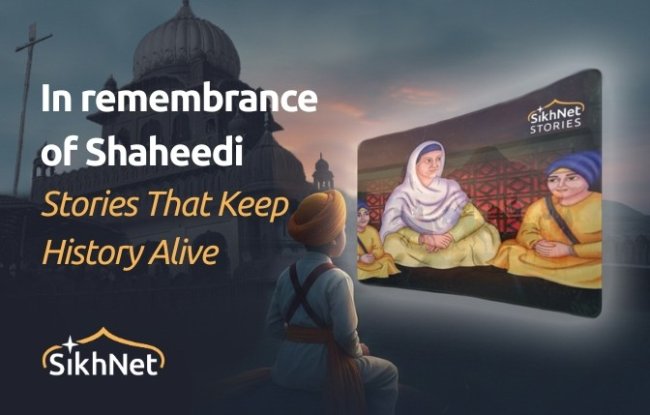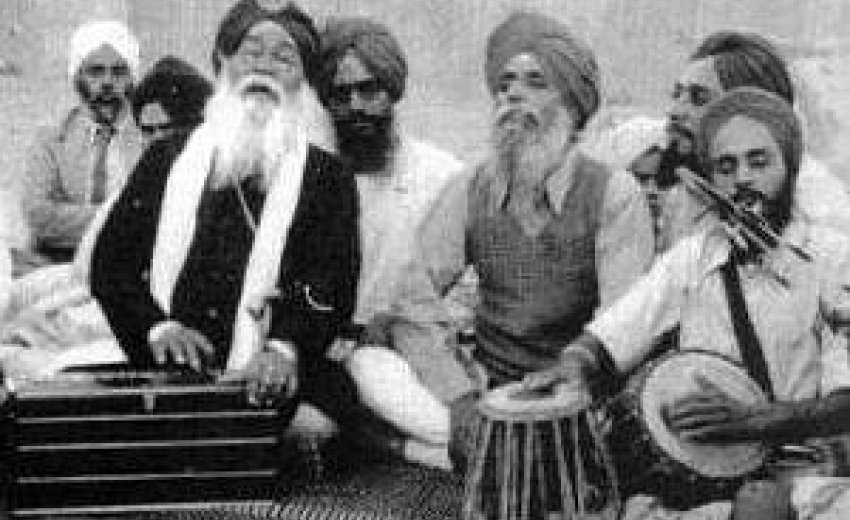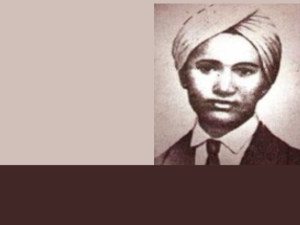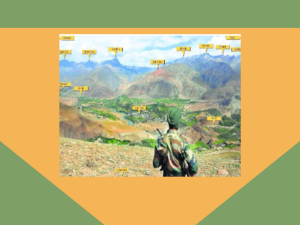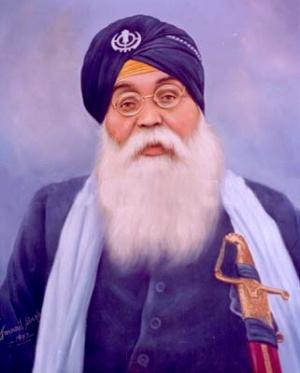 Bhai Randhir Singh (1878-1961), a great freedom fighter, reformer, theologian, and hero of Lahore Conspiracy Case, first prisoner of Gurdwara Reform Movement was a legendry Sikh personality of 19th Century. Born Basant Singh on July 7, 1878, in village Narangwal District Ludhiana, Punjab, in a Grewal family of a very noble and devout heritage, he was initiated into the Khalsa fold and named Randheer Singh. His father, S. Natha Singh Grewal was a learned scholar of Punjabi, Urdu, Persian and English, who initially worked as a District Inspector of Schools but later rose to the rank of a Judge in the High Court of the State of Nabha.
Bhai Randhir Singh (1878-1961), a great freedom fighter, reformer, theologian, and hero of Lahore Conspiracy Case, first prisoner of Gurdwara Reform Movement was a legendry Sikh personality of 19th Century. Born Basant Singh on July 7, 1878, in village Narangwal District Ludhiana, Punjab, in a Grewal family of a very noble and devout heritage, he was initiated into the Khalsa fold and named Randheer Singh. His father, S. Natha Singh Grewal was a learned scholar of Punjabi, Urdu, Persian and English, who initially worked as a District Inspector of Schools but later rose to the rank of a Judge in the High Court of the State of Nabha.
As a Judge, he became well known for combining justice with mercy, compassion and humanity. His mother, Sardarni Punjab Kaur, was a direct seventh-generation descendant of a very devout, eminent, and saintly Gursikh, Bhai Bhagtu, a very distinguished disciple of Sahib Sri Guru Arjan Dev Ji and Sri Guru Hargobind Sahib. Thus, Bhai Randheer Singh inherited scholarship and strength of mmd from his paternal side and qualities of piety and devotion from his maternal side.
He had most of his early schooling in Nabha and his higher education at the prestigious Government and Foreman Christian Colleges at Lahore (in 1896-1900 A.D.), which was, at that time, the capital of the undivided Punjab State. He was not only an intelligent and diligent student with respect to his scholastic pursuits, but was also a good sportsman, having once served as a Captain for the College hockey team. He had a prodigious memory, a fact clearly revealed from the way he has reproduced details of the happenings during his prison life. In his autobiographical letters from prison, he has narrated his long conversations with the jail authorities minutely and distinctly narrated. In his various books on Sikh theology he quotes very appropriate verses from the Gurbani freely and with apparent ease. He had a deep insight and scholarly expertise in Punjabi, Brij Bhasha of Sri Dasam Granth, Persian, Urdu and English. He even distinguished himself as an Urdu and Punjabi poet during his college days.
Even a cursory look at his life, as revealed from his autobiographical letters and related by his close prison and post-prison comrades, clearly shows that he was one of the very few Gursikhs of the century who had full and unfaltering conviction of his faith in the teachings of the Satguru, so much so that he staked his personal career, the safety and welfare of his wife and young children, his ancestral property and even his life in following the true path of Gurmat. He was one of the very few outstanding Sikhs of his time who, as one of the Panj Pyaras, blessed the so-called lowest caste people with the holy Amrit (Baptism of the Double Edged Sword). It may be recalled that those were the times when the Gurmat way of life had been almost completely overshadowed by Hindu orthodoxy or Brahmanism. The Brahmanic principle of untouchability regarding the low caste Hindus and Muslims had become ingrained in the minds of Sikhs to such an extent that the Sikhs would not even consider taking part in the Amrit ceremony in their company.
Bhai Randheer Singh was one of the first few Sikhs of the 20th century who had the courage to be baptized along with a muslim, a well-known family of Maulvi Karim Baksh, whose Amrit Ceremony was arranged on a large Panthic scale on June 14, 1903. As a result, he was treated almost as an outcast by the Sikhs of his own village and even by some of his relatives; the priest of Sri Akal Takhat Sahib did not even let him offer Karrah Prasad and do Kirtan there. However, he remained steadfast in practicing whatever was ordained at the Baptismal ceremony, as well as what he understood from the Holy Sikh Scriptures and authentic Sikh traditions. In fact, the practice and preaching of the Sikh Code of Conduct strictly in accordance with the true Gurmat became his passion in life. Though he belonged to an aristocratic family, his simple way of life, his devotion to Gurmat, and his determination to live strictly in accordance with the Commandments of the Satguru, have very few parallels in the contemporary Sikh society. Throughout his life, he stuck steadfastly to the Code of Conduct enunciated by the Tenth Guru, even at the risk of losing his health and life.
He had the firm belief that initiation into the Khalsa fold was not merely a ritual but meant a new birth into the Spirit of the Guru, provided that the ceremony is conducted strictly in accordance with the rules and procedures laid down by Guru Sahib. At the time of his own baptismal ceremony, a disturbing intrusion by an outsider caused confusion in his mind regarding the true Gurmantra. He felt that there was a Mystic Word prescribed as Gurumantra for the Sikhs which also formed the central theme of the Gurbani - a particular NAAM - and it was possible to repeat it with every breath. He firmly believed that only through constant repetition of, and meditation on, this Mystic Word could complete self realization and oneness with God be attained.
He, therefore, yearned ardently for getting the Gurmantra directly from Sri Guru Granth Sahib and was also confident that he would be blessed with it. He believed Sri Guru Granth Sahib to be the real embodiment of the Ten Gurus and, therefore, prayed only to Guru Sahib for the Bliss of the Holy Naam. With this objective in view, he made a prayerful vow to accept that holy word as the True Gurmantra that was indicated in the first hymn he read or heard in the Gurudwara on one particular morning. If there was any indication of the popularly known Divine Name of Waheguru through such words as Wah or Guru, he would accept Waheguru as the True Naam prescribed for the Sikhs as Gurmantra. How his prayer was accepted, in what a glorious way Guru Sahib blessed him with the Gurmantra, and the technique of its constant repetition, is very beautifully narrated in his autobiographical letters: "As soon as I entered the Gurdwara and bowed before Guru Granth Sahib, these words were being recited:
(Carefree and unconcerned is the Lord, Sayeth Nanak Speak Gurvah)
The words Kaho Gurvah had such a magnetic effect on my mind that immediately my every nerve and pore in the body became imbued with the thrilled music of the Mystic Word Waheguru... To my great surprise I saw some unseen hand wave the chowri over Guru Granth Sahib and in between the canopy and the Guru Granth Sahib, there flashed forth a wave of light forming itself into the divine word Waheguru and moving in space throughout the inside of the temple without any visible support."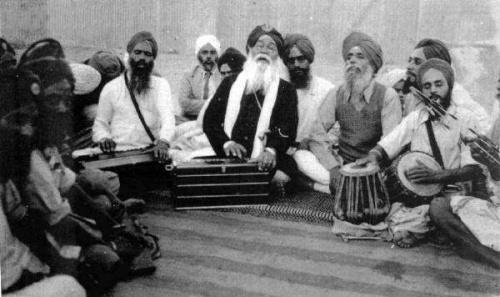 After attaining the true Gurmat Naam from Sri Guru Granth Sahib, he became determined and anxious to attain the Named One, the Lord God Himself. His desire turned into a poignant thirst, and he took to repeating the Naam continuously without any feeling of fatigue or wavering of mind. After attaining the stage of self-realization during which he saw his own soul to be quite distinct from his body, his thirst for seeing the Light of God Himself increased manifold. On the auspicious day of Sahib Sri Guru Nanak Dev ji's Prakash Utsav, in the year 1905, God revealed himself in all His Perfect Resplendence to him in the silence of the midnight meditation which he describes in one of his autobiographical letters as follows:
After attaining the true Gurmat Naam from Sri Guru Granth Sahib, he became determined and anxious to attain the Named One, the Lord God Himself. His desire turned into a poignant thirst, and he took to repeating the Naam continuously without any feeling of fatigue or wavering of mind. After attaining the stage of self-realization during which he saw his own soul to be quite distinct from his body, his thirst for seeing the Light of God Himself increased manifold. On the auspicious day of Sahib Sri Guru Nanak Dev ji's Prakash Utsav, in the year 1905, God revealed himself in all His Perfect Resplendence to him in the silence of the midnight meditation which he describes in one of his autobiographical letters as follows:
"God was now resplendently revealed within me... Ah! Blessed was my search today. I could see a sea of Divine Light flooding within me and outside me in shimmering resplendence... The more I was absorbed in it, the more wonderful and sublimely dazzling spiritual phenomenon were seen by my inner eyes which cannot be expressed in the language of our physical and earthly world... I could see right through the roof and walls of the room in which I was sitting. Right through the sky I could see space beyond space, all crystal clear and bathed in purity. The whole of the universe was filled with incomprehensible light which was penetrating me and enfolding me. The music of His Divine Presence filled my heart with Blissful joy. I could see all this clearly and visibly in a wide awake condition..." 3
After these highly spiritual, mystical, and blissful experiences he resigned his Government job but did not become a hermit. He continued to tread the path of true Gumat which enjoins upon the Sikhs to continue to live in this world without being engrossed in it. He continued to perform his duties to his family and society. He took the initiative in clearing the malpractices in the various historical Gurdwaras. As a reformer, he was not deterred by the strength of the vested interests involved in their management. Once, at Gurdwara Fateh Garh Sahib on a holy occasion, he did not allow the recitation of Gurbani by an unholy and apostate Ragi Jatha, without caring for danger to his life. Again at Anandpur Sahib Gurdwara, on the occasion of Hola Mohalla Celebration, he did not tolerate the malpractices and immoral activities of the powerful management. Risking his own life, he successfully fought against the administration. It was for such deeds of Gurdwara reform that he has been referred to as the pioneer of the Gurdwara Reform Movement. A reference to his services in this respect was also made in the Hukam Namah bestowed upon him from Takht Sri Kesh Garh Sahib in 1905 (Appendix A).
In 1914, when the British rulers razed the wall of the historical Gurdwara Rakab Ganj Sahib in New Delhi to beautify the surroundings of the then newly built Parliament House, it was Bhai Sahib Randheer Singh who not only was the first to protest publicly against this desecration of the Holy Shrine, but also to announce his specific plans to spearhead the agitation until the razed wall was restored. He was also instrumental in organizing two large Panthic Conferences in this connection, at Patti in District Amritsar, and at Lahore, to pass the Resolutions condemning the British action, and demanding the restoration of the razed wall. These conferences were the first of their kind after the British occupation of Punjab. It may be mentioned here that the Chief Khalsa Diwan, the only major Panthic Organization at that time, had expressed its willingness to side with the British Government.4
Although his mind was never in politics, as a true Gursikh who cannot accept slavery and repression, he, along with the Ghadarite emigrants from USA and Canada, became an active participant in the armed revolt against the British Government for the country's freedom. In fact, he was the only outstanding leader from Punjab who, along with his companions, was a participant in this revolt. It is worth noting here that the top Hindu leader of the Indian National Congress, M. K. Gandhi, opposed this revolt and declared his support to the British Government in their First World War efforts, saying, "Was it not the duty of the slave, seeking to be free, to make the master's need his opportunity?...it was our duty to win their help by standing them in their need."5 Earlier the so-called Punjab Kesri, Lala Iajpat Rai, called these Ghadarite emigrants fanatics and dangerous to the national cause.6
The revolt failed due to leakage of plans by traitors from within, and he and his companions were arrested on May 9, 1915 and tried in what is commonly known as the Second Lahore Conspiracy case. However, his love for the country's freedom arose solely from the ideals of the Sikh Dharma, and whatever he did for the country he did primarily as a true Gursikh and not merely as a political freedom fighter. He was sentenced to life imprisonment in 1916 and his property confiscated. He was only 38 years old with a wife and three young children. The eldest ten year old daughter could not bear this separation from her dear father and died within a month of his imprisonment. His son Balbir Singh was only six years old, and his daughter Daler Kaur was just two.7
During his prison term of over 15 years, he faced unprecedented sufferings. This was not for any political or personal reasons, but only for his determination to live strictly in accordance with the Khalsa Code of Conduct made known to him at the time of initiation into the Khalsa fold. In Multan jail, one of the hottest places in India (now in W. Pakistan) with temperatures going up to 122°F in May and June, he remained without food and water continuously for 40 days. This was because he was not allowed to prepare his food himself according to the Gurmat principles and he would not take food prepared by non-Amritdharis. He was chained to iron gates in the open for many days to face the scorching heat of the sun and bear the brunt of hot winds. At night he was put into a 6' x 4' cell without ventilation. This is only one instance of the many tortures inflicted upon him. He had to bear such terrible sufferings in prison that twice he was given up for dead even by members of his own family. Even after suffering such inhuman tortures, he remained steadfast in his beliefs and never once wavered from following strictly the Khalsa Code of Conduct. When the Khalsa Panth came to know of his tortuous sufferings, the whole Panth observed February 1, 1923 as a special day of prayer for him in particular and for other suffering Sikh prisoners in general.
Prior to his release from prison in Lahore, the well-known Shaheed Bhagat Singh, who was waiting execution in the same prison, expressed a desire to have Bhai Sahib's darshan before his death. On being approached, Bhai Sahib refused to see him saying "...he has violated the basic tenets of Sikhism by shaving off his hair and hence I do not want to see him." Bhagat Singh was quick to express his repentance and also confessed that he, in fact, was an atheist at heart. He further told Bhai Sahib that even then, perhaps, he would have kept the Sikh appearance, but if he had done that he would have lost the friendship and sympathy of his Hindu comrades and would not have received so much publicity in the press. After a two hour meeting with Bhai Sahib, he became a true Sikh at heart and later went to the gallows as a true believer in Sikhism.
Soon after his release in 1930, Bhai Sahib was honored by Sri Akal Taldit Sahib with a Hukumnamah and a robe of honor, recognizing his steadfastness in faith and selfless sacrifices (Appendix A). He is the second person to have been honored by Sri Akal Takht Sahib during this century, the other person being Baba Kharak Singh, the renowned Panthic leader of the late twenties. Afterwards, the other three Takhts also honored him in the same way, thus making him the only single person to have been honored from all the original four Takhts in the last hundred years of Sikh history. (Damdama Sahib was declared the fifth Takhat later). Robes of honor and a gold medallion were also sent to him by the Sikhs of U.S.A. and Canada. He was selected as one of the Panj Pyaras to inaugurate the Kar Seva of the sarover of Gurdwara Tarn Taran Sahib, and to lay the foundation stones of the new buildings of the Gurdwaras at Panja Sahib and Shahidganj Nankana Sahib, besides those of the Bungas at Patna Sahib and Kavi Darbar Asthan at Paonta Sahib.
After his release from prison, he lived for over thirty years during which time he travelled throughout the country and propagated the true Gursikh way of life through Gurbani Kirtan and Paath. A large number of ardent seekers of the true path of Sikhism were drawn to him magnetically, and he directed them to and brought them in direct touch with the infinite wealth of Gurbani. In this way, the Akhand Kirtani Jatha came to be formed. According to him, the principles of life pointed out in Gurbani and prescribed in the Khalsa Code of Conduct are not merely ideals but downright practical. He himself conformed to and lived in accordance with these principles in letter and spirit, even in the midst of the most unfavorable and tortuous circumstances of jail life. It is now a fact of history that his bold stand and endurance of untold sufferings for retaining the Sikh symbols in jail resulted in the amendment of the Jail Manual, which permits all the Sikh prisoners to wear Turban, Kachhehra and Karra in jail. Prior to that time, they were forced to wear caps and Langoties and were deprived of the Karra.
He wrote about two dozen books on Sikh theology, philosophy and the true Sikh way of life (Appendix B). Of these, the most well-known is his Autobiography, a collection of his letters written from prison during his sixteen years of imprisonment. This book reveals his personal spiritual experiences of the highest state of divine illumination. According to Bhai Sahib Vir Singh, these experiences "...will give convincing testimony of the fact that our faith, the contemplation and remembrance of the divine Name has now been tested by an experiment in the crucible of his own self by a scholar educated and trained in Western lore."8 It also reveals that his whole life has been a saga of suffering in which he never for a moment left his deep faith and devotion to God and His Word.
With regard to his other books, it may safely be said that during the current century, he is perhaps the only writer on Sikh theology who has written comprehensively, and with the confidence arising out of first-hand personal experiences of the highest state of Divine illumination, on such subjects as Anhad Shabad (Unstruck Limitless Music), Gurmat Karam Philosophy (Law of Karma), Sach Khand Darshan (Vision of the Realm of the Truth), Jyot-Vigas (The Revelation of Light), Andithi Dunya (The Unseen World), etc. Dr. Tarlochan Singh rightly says that "...In his writings we find the glow of his mystic experiences, his intellectual certainty and the metaphysical clarity of his theology."
The steadfastness of his character, conviction of his faith, and firmness in his allegiance to the high Sikh traditions are revealed from another remarkable incident in his life. Before his imprisonment, he was an intimate friend of Babu Teja Singh of Bhasaur and was also instrumental in establishing Panch Khalsa Diwan at Bhasaur in association with him. Babu Teja Singh was then quite a dynamic personality amongst the Sikhs and was a leading figure in the Singh Sabha resurgence. The Panthic Conference, where Bhai Sahib had taken Amrit along with Maulvi Karim Baksh and his family, was also organized by Babu Teja Singh. Hence both of them had become close friends. However, as Babu Teja Singh became a British Government loyalist, Bhai Sahib stopped working in association with him. During the period of Bhai Sahib's internment, Babu Teja Singh had been excommunicated from the Panth.
After Bhai Sahib's release, Babu Teja Singh tried to meet his old friend after twenty years and came to his house to resurrect their old friendship. Bhai Sahib was not there at that moment. When he came to know later of Babu Ji's visit, Bhai Sahib wrote him a letter politely declining to meet him. The contents of the letter are very moving and reveal the true personality of Bhai Sahib and his unshakable and abiding faith in the Sikh tenets, values and traditions. It is therefore considered worthwhile to reproduce the English translation of the same below:
"Babu Teja Singh ji, Waheguru ji ki Fateh. You, dear Sir, have come to see this humble servant of the Panth after one fifth of a century, i.e., 20 years. I was no less eager to have the chance of meeting with you and talking together. But I was deeply pained when I learnt that you have been excommunicated from the Panth by a congregation at Sri Akal Takht. What is even more distressing, you continue to disregard the authority of the Panth. It is now my request that you should be obedient to the Command of the Guru Panth and return to its shelter. Then we shall meet like brothers. It is my hope that you will accede to my request and thereby please the hearts of all of us. I am confident that you will not defy the Guru Panth and will abide by the tradition coming down through generations. Your sincere well wisher (s) Randheer Singh"9
Thus, no personal relationship would deflect Bhai Sahib from obeying in letter and spirit the edicts of the Guru Panth issued from Sri Akal Takht Sahib.
This very brief sketch of his life given above brings out clearly that he lived the life of the highest concept of man evolved in about two and a half centuries by Sahib Sri Guru Nanak Dev Ji in his ten manifestations. In spite of all these high spiritual achievements, he always remained humble and full of humility. He made stupendous sacrifices but never publicized them. He never felt hatred against even his adversaries who inflicted on him all types of tortures as he took all this as the Will of the Guru. He had a sizable group of associates attending and performing Kirtan at the Akhand Kirtan Samagams, but he did not organize them into a separate sect nor establish a separate Dera or Ashram as done by many other saints. He even refused to nominate anyone to head the Jatha as his successor and instructed that all the matters of importance and urgency be decided by the Panj Pyaras selected by the Sangat for that purpose.
He never even requested the Government of the Independent India to release his land, which had been confiscated by the British Government at the time of his arrest, and held in possesion by the Indian Government until 1950. No pension or benefit as a freedom fighter was given to him or his family. This was because he would not personally seek any favour from anyone, not even the Government of free India, as a reward for his sacrifices in the freedom struggle.
Right from 1900 A.D., Bhai Sahib Randheer Singh had been a very well-known personality among the luminaries of the Sikh Panth. During the days of Baba Kharak Singh's leadership, he was always at the center of all religious and political activities of the Sikhs. However, after 1947, Akali Dal leaders started sidetracking him as well as Baba Kharak Singh, treating both as un-persons. This was mainly because, in their company, the Akali and other leaders could not afford to fulfill their own selfish ends. Bhal Sahib, noting decadence in the Panthic leadership, had himself remarked a few years before his death:
"...This is the beginning of the end of all these decadent parties and religious organizations. New blood and newly inspired political organizations alone will deliver goods in the future..."10
His life story thus explicitly brings out that, as Dr. Tarlochan Singh puts it:
"...He was a God-intoxicated man, consumed with religious enthusiasm in the literal sense of the word and 'holding God within' as one would say; yet he was a practical leader capable of dedicated service to humanity and his country. His faith and virtues were near allied and mutually indispensable...With astounding faith and stoicism he suffered all his life for the ideals which form the cornerstone of Sikhism such as Freedom, Justice, Equality and Truth."11
Throughout his life, everything he did reveals his integrity of character and faith, absolute lack of ego, and extremely disciplined and spiritually enlightened life based on the Code of Conduct enunciated by the Satguru
Bibliography:
1.Harbans Singh: Encyclopedia of Sikhism
2.Narinder Singh Sall "Brief Biological Sketch of Bhai Sahib Randheer Singh"
3.SikhiWiki
